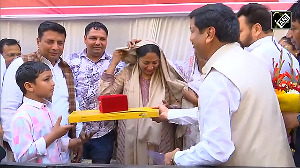Congress party President Sonia Gandhi's recent visit to China was already described as a milestone in Sino-Indian relations.
While Mrs Gandhi was 'amazed and astounded at the progress made by the people of China and its leadership,' Chinese Minister Wang Jiarui had eulogistic words to welcome her: 'Your visit has captured the attention of the whole world.'
Whether true or not, one cannot deny that the Chinese leadership rolled out the red carpet for her. She was the first leader to meet with President Hu Jintao and Premier Wen Jiabao after their mandate to the Politburo Standing Committee of the Communist Party of China Central Committee was renewed.
In her address to the School of Public Policy and Management at Tsinghua University organised by the International Department of the CPC, the United Progressive Alliance chairperson praised China which has 'shown the world how much could be achieved with pragmatism, clarity of vision and determination of effort.'
A few weeks later the bonhomie was further demonstrated by the joint military exercises between India and China. You may have read: 'As much as learning anti-terror skills from the Indian Army, yoga too has caught the fancy of the Chinese troops... the People's Liberation Army men seemed to have been swayed by yoga, they are learning pranayama, which is believed to do wonders in physical and psychological performance, and asanas from instructors of the Indian army.' Bhai Bhai again!
In other words, the circumstances surrounding Dr Singh's visit are most propitious. This was also pointed out by Chinese foreign ministry spokeswoman Jiang Yu. Beijing was the first to broach the subject of the forthcoming visit; in the coming days, we will probably have a long series of congratulatory communiques.
Jiang said one of the topics scheduled to come up for discussion is the 50-year-old border issue (the first exchange of letters between Delhi and Beijing on Aksai Chin dates from 1957-1958).
When asked about the dispute, Jiang declared that both sides wanted to find a 'fair and rational' settlement to the vexed boundary problem: 'We will make joint efforts to try to find a fair and rational settlement acceptable to both countries.'
She added: 'We hope that with the visit the two countries can promote the healthy and long-term development of a strategic partnership.'
With all these niceties, one would nearly forget that China occupies 38,000 square kilometres of India's territory and still claims the whole of Arunachal Pradesh (a whopping 90,000 square kilometres).
True, there is enough good news not to be bothered by the border issue. Take business for example; it has never been so brisk between the two Asian giants. Trade has been expanding at an incredible pace; it has reached a staggering 34.2 billion dollars (about Rs 136,800 crore) from January to November 2007, up 54 percent from the previous year.
For reluctant optimists like me, there are still some inconvenient truths. I believe that the time has come for India to follow the example of China who, in Mrs Gandhi's words, has 'shown the world how much could be achieved with pragmatism, clarity of vision.'
Pragmatism tells us that around 300 cases of intrusions on Indian soil by the Chinese have taken place over the last two years, though during his recent visit to Sikkim, India's Defence Minister A K Antony has denied this hard fact. Most of these incursions have occurred in Arunachal Pradesh which is persistently claimed by the Chinese ambassador as a part of China though this assertion is historically a lie.
While doing some research on the missionaries who tried to penetrate Tibet during the 19th century, I recently came across the interesting journal of a French missionary called Nicolas Krick. He describes in great detail the areas south of the McMahon Line and particularly the Anjaw (ex-Lohit) district of what is today Arunachal Pradesh. Whatever might have been his motive, it is clear from the missionary's account that no Chinese had ever set foot in the area. All visitors agree on this.
The Chinese first reached there in October 1962 only; at that time the Indian Army heroically defended the small hamlet of Walong, a couple of days walk from Rima, the Tibetan border post which the French missionary had wanted to evangelise.
Taking his first lessons in pragmatism (from the Chinese?), Antony admitted the sorry state of affairs of India's preparedness. He was frank enough to declare: 'It is an eye-opener for me. There is no comparison between the two sides. Infrastructure on the Chinese side is far superior. They have gone far in developing their infrastructure.' After saying that China was far ahead in defence preparedness, he promised that he would take vigorous steps to develop the frontier areas to match China.
'Clarity of Vision' shows that the so-called border dispute is bogus. It is only a Chinese bluff to regularise their illegal occupation of Aksai Chin.
Today like yesterday, the main problem is that while the Chinese remain pragmatic, most of the Indian leaders are too sentimental. A Bhai-Bhai policy is so much more romantic than a firm stand!
A year ago, on the sidelines of the last ASEAN summit at Cebu in the Philippines, after Dr Manmohan Singh and Wen Jiabao, his Chinese counterpart, had discussed the border issue, National Security Advisor M K Narayanan told the press that Wen 'went to great lengths to express the view that whatever anybody might say, whatever anybody might try to interpret, India and China are friendly neighbours, and have a shared common view on how the world should be looked at.'
It was enough to melt the heart of the good Indian prime minister who agreed that the two sides could solve and were willing to solve the 'dispute'; thereafter they decided to work with 'greater vigour and greater innovativeness.'
I have never understood from where then prime minister A B Vajpayee pulled out the bright idea to open new border talks with China in June 2003. At that time his move surprised everybody (including the Chinese). Did Vajpayee consider the eventual end-result of his action? His move could only place Beijing in a win-win situation.
If Vajpayee believed that he would get a quick settlement (and quick glory), he was wrong! Nehru had tried before. Senior Indian and Chinese officials had five rounds of detailed discussions between June and December 1960, no agreement was ever in view. While India presented detailed maps and documents proving its claims, the Chinese could not give any evidence in support of their 'possession'.
Today, the Indian side repeats that it is 'happy with the progress of the talks' and the Chinese keep intruding while Delhi continues to keep quiet so as not to jeopardise the so-called 'negotiations'.
External Affairs Minster Pranab Mukherjee may say that the negotiations are moving in the right direction, but what is the final goal? Is India ready to give away part of its territory which has been illegally occupied by China? This is the only question to be answered.
In the meantime, the Chinese keep sending grazers and intruders to the Indian side of the Line. With the Confidence Building Measures in place, the Chinese know perfectly well that they will get away with retaliation. India will not be able to give what is known as 'a bloody nose' in army jargon; the CBMs therefore have become an alibi for the Chinese to continue creating an atmosphere of uncertainty.
Remember June 1986! The People's Liberation Army had intruded into the Tawang district. They tried to occupy the Wangdung IB observation post which is used in summer as a yak grazing hamlet. The Indian army stood firm on the ground and threw out the trespassers.
Then army chief General V N Sharma wrote: 'It was with renewed confidence that Rajiv Gandhi could plan his visit to China (in 1988.'
By taking a strong stand, India showed the Chinese that they could not bluff their way through into Indian territory.
Is weak denials of the obvious or declarations that we are in the right track, the best way to prepare for the prime minister's visit to China? Having lived 50 years with the LAC, India can live another 10 or 20 more years as it is!
In many ways, it would be better to say today, 'Let us forget the border talks, and concentrate on more urgent issues such as stopping the cross-LAC nibbling, 'softening' of the LAC by opening new border posts or signing an agreement on the trans-border rivers from Tibet.'






 © 2025
© 2025